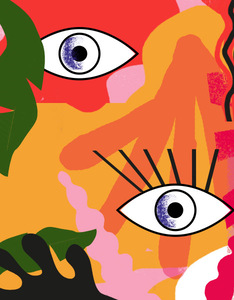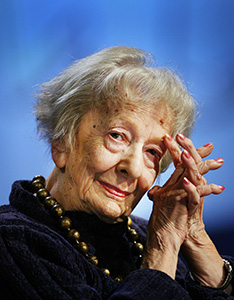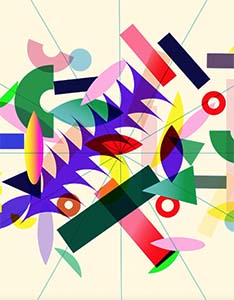Expo 2025 Osaka: Adam Mickiewicz Institute announces first events of its cultural programme
The World Expo 2025 Osaka, hosted by Japan for the third time, will be inaugurated on 13 April. The event will be accompanied by a unique cultural programme under the slogan Po!land ポ!ランド, organised by the Adam Mickiewicz Institute. The programme will go beyond the space of national pavilions to make its mark at the very heart of the city. The Institute has just announced first events of the programme that will continue until October 2025.
The slogan of the cultural programme – Po!land ポ!ランド – is inspired by the Japanese onomatopoeia “Po!”, used to express the moment of epiphany and pleasant surprise. This joyful “Po!” also alludes to polonium – an element discovered by Maria Skłodowska-Curie and symbolising innovativeness, science, and transgressing borders. Juxtaposed with “ランド” (rando), borrowed from the English “land”, Po!land becomes a space for exchanging ideas, meeting of cultures, and mutual inspirations.
The programme presenting the Polish culture in Japan is a result of a multi-annual, consistent building of relationships with partners in the Kansai region. As emphasised by organisers – we do not arrive in Osaka as guests, but as contributors. Our presence in Kansai is not a one-off project, but another chapter in our common history based on dialogue and cooperation.
From 31 May, at the Daimaru department store, the exhibition “Wearable Art – Unseen Threads” by Joanna Hawrot will be available to viewers. It is a spectacular installation stretching across eight storeys and consisting of fashion items, tapestries, and new media. The project combines Polish tapestry tradition with Japanese aesthetics, thus creating a transcultural narrative on identity and visibility.
In June, a project of one of the most interesting Japanese artists of the young generation – Yuriko Sasaoka – will be presented at the prestigious Osaka City Central Public Hall. An installation “Polonia x Skłodowska-Curie’s Magic Lab. The Power of Migration”, prepared in collaboration with Polish authors, retells the story of Maria Skłodowska-Curie as a symbol of migration of ideas and knowledge.
The programme will also include concerts of Polish jazz and alternative music. In autumn, such artists as Kinga Głyk and Małe Instrumenty will perform at the vibrant Namba Square – one of the central points of Osaka – together with Japanese artists invited to contribute.
By linking artists from Poland and Japan, we are creating space for ventures, experiments, and discovery of new meanings in art, science, and urban landscape of Osaka. We want the programme created together with Japanese partners and art milieus to become a basis for further long-term collaboration in the region – says Olga Wysocka, Director of the Adam Mickiewicz Institute.
Full programme of events will be announced on 15 April 2025.
- 31 May – 24 June: Exhibition “HAWROT: Wearable Art – Unseen Threads”, Daimaru Shinsaibashi, Osaka
At the prestigious Daimaru Shinsaibashi department store, being one of the historical symbols of the Kansai region, an exhibition of Joanna Hawrot – a project at the borderline of fashion, art, and narrative about contemporary identity – will be presented. It will feature original artefacts and tapestries alluding to the works of Magdalena Abakanowicz, Wojciech Sadley, and Angelika Markul. The artist selected 12 women from Poland and Japan and reproduced their personal histories in her creations. The result is twelve unique outfits inspired by jūnihitoe (literally “twelve layers”) – a traditional court attire from the Heian period. The artist invited elderly, transsexual, and socially excluded persons to collaborate, thus drawing attention to groups that are rarely represented in the world of fashion. Concealed in a fabric, personal experiences of participants form a polyphonic narrative on what is visible and what is hidden – both in fashion and in culture.
The project is organised in partnership with the Central Museum of Textiles in Łódź.
- 14 June – 5 July 2025: Exhibition “Yuriko Sasaoka: Polonia x Skłodowska-Curie’s Magic Lab – The Power of Migration”, Osaka City Central Public Hall
One of the highlights of the programme will be a multimedia installation by Yuriko Sasaoki – prepared at the invitation from the Adam Mickiewicz Institute – which will be available for viewing from 14 June at the Osaka City Central Public Hall. The installation invokes Maria Skłodowska-Curie and is a form of homage to all women of science. It also shows the complexity of the term “migration”, which can refer not only to people, but also to ideas. Sasaoki’s work triggers reflection on how movement and exchange of thoughts help shape identity and perception of own roots. The artist invited Polish collaborators: Tomasz Koszewnik and Daniel Koniusz, thus reinforcing Polish-Japanese relations.
- 3-4 October 2025: Alternative and jazz music concerts, Namba Square, Osaka
In autumn, Namba Square will host concerts performed by Polish alternative and jazz artists, among others, Kinga Głyk and Małe Instrumenty, who invited Japanese artists to participate. This will make an opportunity to establish a musical dialogue between Poland and Japan, as well as to present unconventional, innovative, and energetic side of Polish musical scene. The band Małe Instrumenty will host musical workshops drawing the works of Frederic Chopin closer to the public through playing them on a toy piano.
The events are organised as part of the programme for promoting Polish culture accompanying the World Expo 2025 Osaka, Kansai. Polish Investment and Trade Agency is a partner to the project and is responsible for the organisation of the Poland Pavilion. The project is co-financed by the Ministry of Culture and National Heritage.
- The first retrospective exhibition of Koji Kamoji in Japan
Parallel to events taking place in relation to the World Expo 2025, Polish culture will also be hosted in Tokyo. Already on 8 April an exhibition “Don’t Let the Unnecessary Overshadow the Whole / 不必要なもので全体が混乱しないように”), presenting the works of Koji Kamoji, will be opened at the Watari Museum of Contemporary Art. It will be a unique opportunity to become familiar with the work of one of the most important contemporary Polish artists. A retrospective exhibition comprises Kamoji’s works stretching from the 1960s to most recent creations, presenting minimalist works of art inspired by zen philosophy and the idea of simplicity and harmony. The event is co-organised by the Zachęta National Gallery of Art and the Adam Mickiewicz Institute. The communication support for the project is provided by the Polish Investment and Trade Agency, the organizer of Poland’s participation in the World Expo 2025 Osaka, Kansai.
More information: www.iam.pl
Media contact:
Joanna Andruszko
email: [email protected]
Phone: +48 693 974 686


